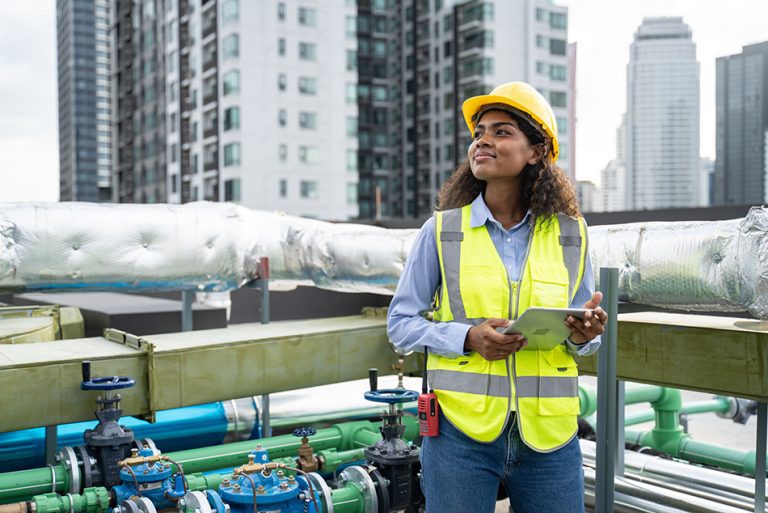Pallet jacks are essential material handling equipment that supports a wide variety of applications across different industries. Its primary use is transporting heavy cargo loads across moderate distances. A manual pallet jack is one such type that allows operators to lift and move heavy loads. Activating it requires the operator to pump the equipment’s handle, which in turn, engages the hydraulic mechanism to raise the pallets and forks from the ground. The operator then pushes or pulls the load with no additional support, using their physical exertion to transport the jack and its cargo to its intended destination. An electric pallet jack carries and moves loads as well. Only this time, the jack bears the majority of the cargo’s weight, leaving the operator to pull only the fairly light base of the equipment, which has fairly little resistance. With this change, productivity in all sorts of workplaces drastically increases. This is especially true in construction sites or places with plenty of heavy pieces of inventory. The lighter weight doesn’t only benefit the operator and their stamina, it has massive ramifications in the workplace. Let’s take a closer look at how electric pallet jacks can transform your material handling operations for the better. 1. It Reduces Operator Fatigue Manual pallet jacks rely on the operator’s strength and stamina. If the operator is experiencing fatigue or injury due to constant exertion of the body, this can force them to stop pulling the jack and, consequently, halt workplace productivity. However, this can be mitigated by using an electric pallet jack in the workplace. This pallet jack type uses a motorised system with adjustable controls to lift and move cargo. This very system does all the work to bear the weight of the cargo load—meaning that mobilising your cargo load becomes as easy as dragging an empty grocery cart across the aisle. With this feature, operators won’t tire out as easily, making them less prone to experiencing fatigue. This increased energy return also helps pallet jack operators maintain good bodily health in the long term. This shapes your workplace into a happier and less stressful one—which can help loads in boosting company morale and productivity. Do you want to use an electric pallet jack to boost your operations? Hire Electric Pallet Jacks from Noble Lift Australia to test out these revolutionary pieces of equipment. 2. It Has a Higher Load Capacity Another way electric pallet jacks revolutionise material handling processes is by having a superior load capacity. Typically, manual jacks can only carry loads of up to 3,500 pounds. This load limit can be even lower depending on the carrying capacity of the operators themselves. On the other hand, electric pallet jacks can carry loads of around 4,500 pounds. This additional 1,000 pounds allows you to carry far more cargo, despite the similar sizes of the two pallet jacks. To put it in perspective, for every three rounds you’ll have to make with an electric pallet jack at full capacity, you’ll be making an additional round with a manual pallet jack. This can be a difference maker in terms of timing and productivity if you’re carrying multiple loads across far distances. 3. It Lowers Operator Injury Risk Besides the reduced fatigue levels, the operator will also be less prone to injuries by operating an electric pallet jack. The motorised machine does all the heavy lifting, eliminating the need for operators to strain their back and forearm muscles. Workplace injuries are common in industries that deal with material handling, as they typically entail the mobilisation of heavy goods as a bulk of their operations. With an electric pallet jack, this risk is greatly minimised, as there won’t be as much exertion on the operator’s part. The utilisation of equipment also reduces the risk of human error during operations, making it a much safer endeavour overall. By taking proactive measures to minimise injuries in the workplace, companies will also become more able to amply protect themselves from shouldering hospitalisation costs and lawsuits for an unsafe work environment. This can save businesses thousands of uninsured dollars in the long run, so it’s something to consider if you’re looking to run your business over the long term. 4. It Increases Workplace Efficiency Another way electric pallet jacks revolutionise the work environment is by greatly enhancing workplace efficiency. Manual pallet jacks, when fully loaded, are heavy and difficult to drag and push. This not only increases the risk of physical tiredness, but it also takes significantly more time to complete the task. On the flip side, operators using an electric pallet jack can easily let their motorised machine do the bulk of the grunt work. This ensures operations become more predictable and quicker, which is crucial in fast-paced environments like warehouses and distribution centres where timing is of the essence. Furthermore, using an electric pallet jack also lowers the need for ground workers to take breaks as often. This improves overall productivity and makes the supply chain move quicker—leading to increased customer happiness, faster fulfilment, and better use of the business’s resources. 5. It Offers Flexible Charging Options Electric pallet jacks run on a lithium-ion battery system that lasts three to four hours from a full charge. In many cases, this is more than enough to fulfil most daily operations in a warehouse or fulfilment centre. When not in use, this electric pallet jack system can easily be plugged in and charged. When timed right, this can mean little downtime when the equipment is in use. That said, if the electric pallet jack requires constant utilisation and runs out of power, operators may also swap the batteries and replace them with a fully charged set. This makes operations run more seamlessly across multiple shifts. 6. It Has Automated Braking Features Another advantage of an electric pallet jack is its built-in automated braking system. These brakes make it easier to control the equipment and its cargo on uneven surfaces, such as ramps, without exerting much effort. It also enhances






